Abstract
The human gene encoding the Ia-associated gamma (or invariant) chain was isolated by screening a genomic library in phage lambda with cDNA probes. The frequency of positive clones in the library, the overlapping restriction maps of the cloned fragments, and the patterns of genomic hybridization suggested that the gamma-chain gene exists as a single copy per haploid genome. The gene consists of 8 exons, spanning approximately 12 kilobases of DNA. All exon sequences were in an open reading frame, contained appropriate splice junction sequences, and encompassed the entire sequence of full-length gamma-chain mRNA, suggesting that the gene we isolated is most likely functional. Furthermore, "CAAT"-type and "TATA"-type promoter sequences were found at the expected positions upstream from the proposed cap site. The organization of the gamma-chain gene has none of the distinctive features of the immunoglobulin superfamily of genes, of which Ia alpha and beta chains are members. Therefore, the evolutionary origins, and perhaps the functions, of the Ia gamma chains are distinct from those of the other two Ia subunits alpha and beta. Despite the unrelatedness of these genes, consensus sequences found approximately 150 base pairs upstream from all the Ia alpha- and beta-chain genes sequenced to date were also found in analogous positions in the gamma-chain gene, suggesting a possible role in the coregulation of expression of these genes.
Full text
PDF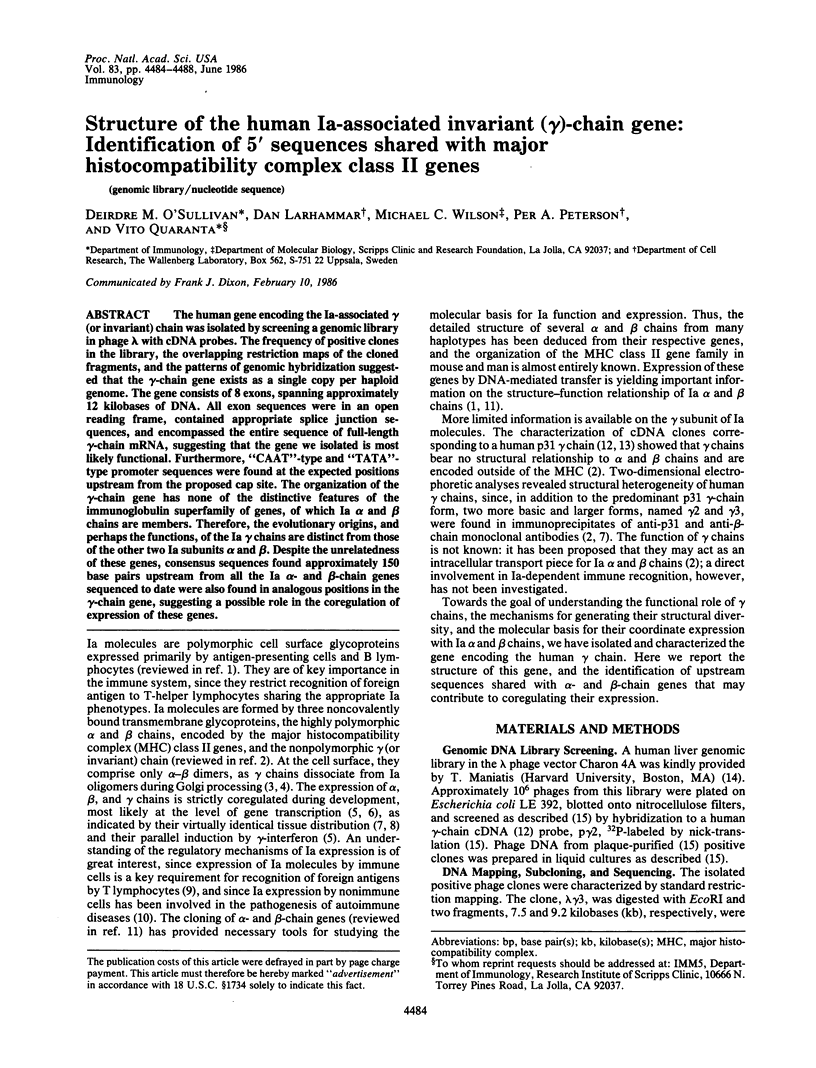
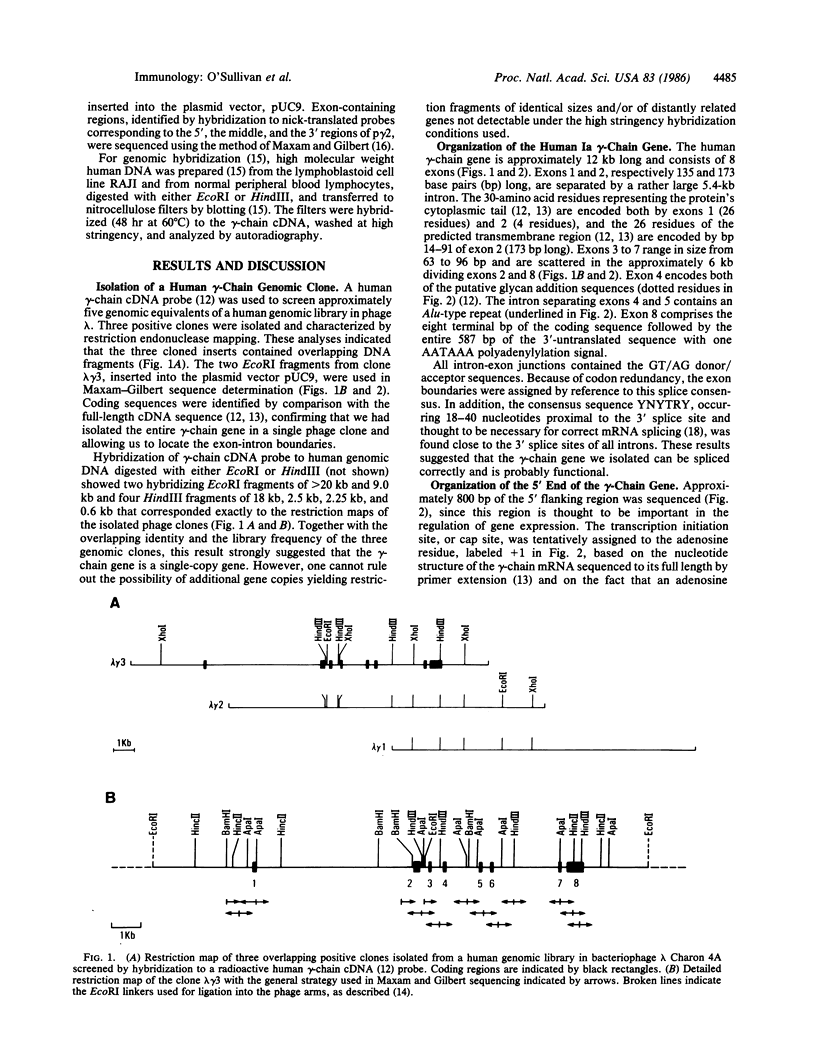
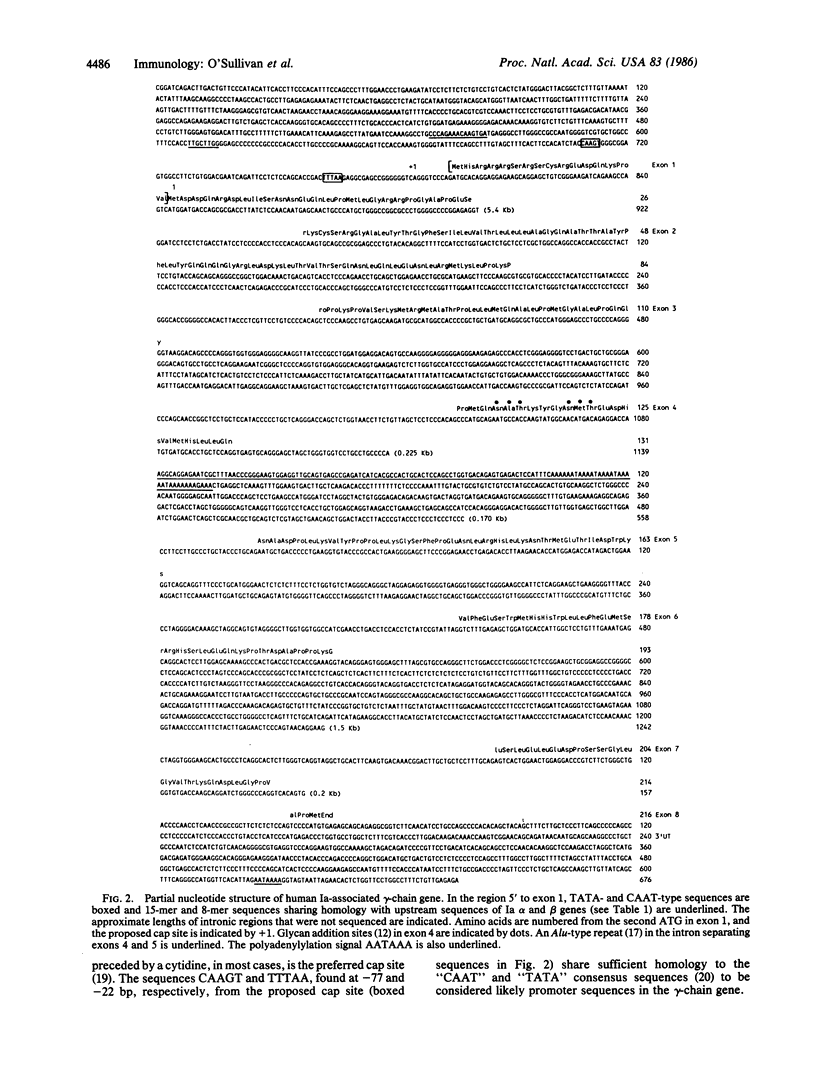
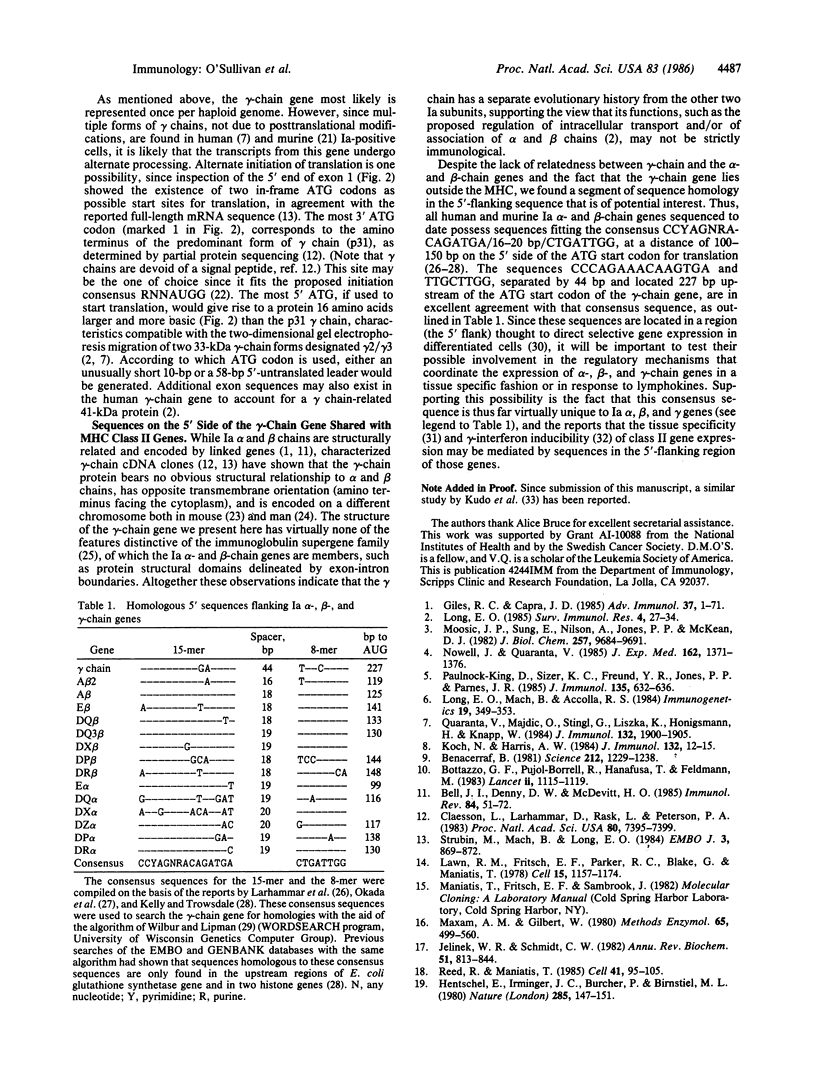
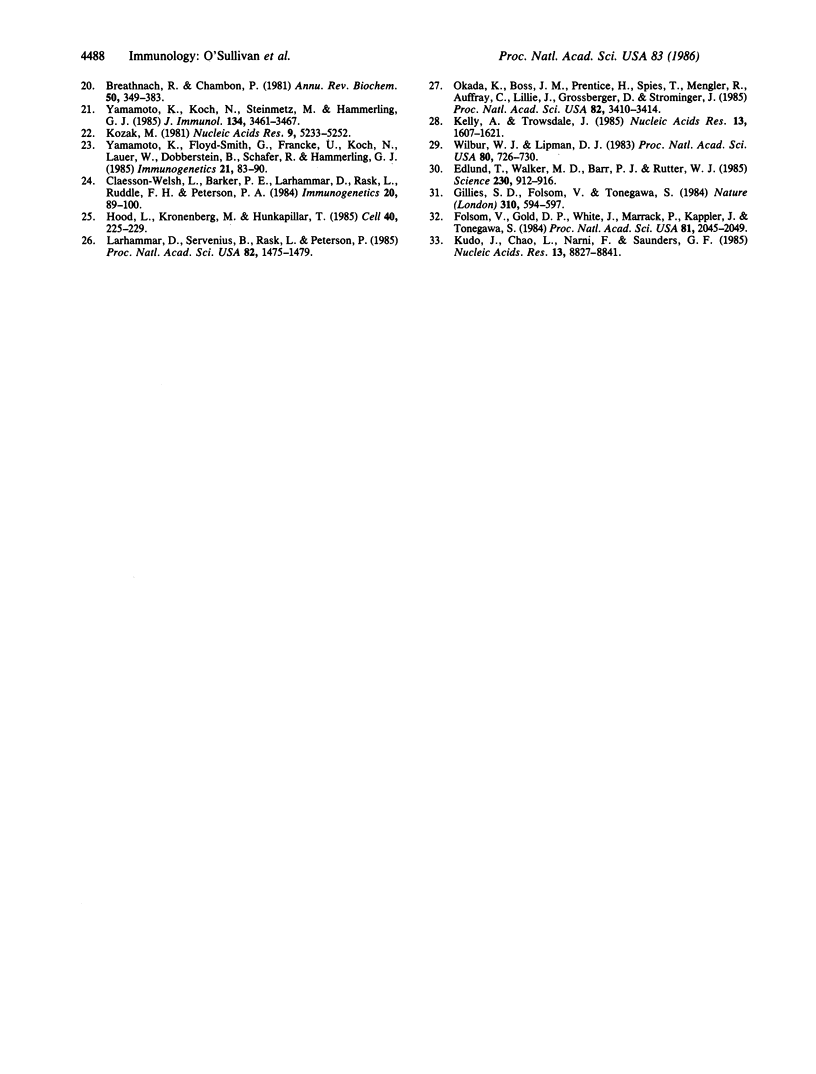
Selected References
These references are in PubMed. This may not be the complete list of references from this article.
- Bell J. I., Denny D. W., Jr, McDevitt H. O. Structure and polymorphism of murine and human class II major histocompatibility antigens. Immunol Rev. 1985 Jul;84:51–71. doi: 10.1111/j.1600-065x.1985.tb01125.x. [DOI] [PubMed] [Google Scholar]
- Benacerraf B. Role of MHC gene products in immune regulation. Science. 1981 Jun 12;212(4500):1229–1238. doi: 10.1126/science.6165083. [DOI] [PubMed] [Google Scholar]
- Bottazzo G. F., Pujol-Borrell R., Hanafusa T., Feldmann M. Role of aberrant HLA-DR expression and antigen presentation in induction of endocrine autoimmunity. Lancet. 1983 Nov 12;2(8359):1115–1119. doi: 10.1016/s0140-6736(83)90629-3. [DOI] [PubMed] [Google Scholar]
- Breathnach R., Chambon P. Organization and expression of eucaryotic split genes coding for proteins. Annu Rev Biochem. 1981;50:349–383. doi: 10.1146/annurev.bi.50.070181.002025. [DOI] [PubMed] [Google Scholar]
- Claesson-Welsh L., Barker P. E., Larhammar D., Rask L., Ruddle F. H., Peterson P. A. The gene encoding the human class II antigen-associated gamma chain is located on chromosome 5. Immunogenetics. 1984;20(1):89–93. doi: 10.1007/BF00373450. [DOI] [PubMed] [Google Scholar]
- Claesson L., Larhammar D., Rask L., Peterson P. A. cDNA clone for the human invariant gamma chain of class II histocompatibility antigens and its implications for the protein structure. Proc Natl Acad Sci U S A. 1983 Dec;80(24):7395–7399. doi: 10.1073/pnas.80.24.7395. [DOI] [PMC free article] [PubMed] [Google Scholar]
- Edlund T., Walker M. D., Barr P. J., Rutter W. J. Cell-specific expression of the rat insulin gene: evidence for role of two distinct 5' flanking elements. Science. 1985 Nov 22;230(4728):912–916. doi: 10.1126/science.3904002. [DOI] [PubMed] [Google Scholar]
- Folsom V., Gold D. P., White J., Marrack P., Kappler J., Tonegawa S. Functional and inducible expression of a transfected murine class II major histocompatibility complex gene. Proc Natl Acad Sci U S A. 1984 Apr;81(7):2045–2049. doi: 10.1073/pnas.81.7.2045. [DOI] [PMC free article] [PubMed] [Google Scholar]
- Giles R. C., Capra J. D. Structure, function, and genetics of human class II molecules. Adv Immunol. 1985;37:1–71. doi: 10.1016/s0065-2776(08)60337-5. [DOI] [PubMed] [Google Scholar]
- Gillies S. D., Folsom V., Tonegawa S. Cell type-specific enhancer element associated with a mouse MHC gene, E beta. Nature. 1984 Aug 16;310(5978):594–597. doi: 10.1038/310594a0. [DOI] [PubMed] [Google Scholar]
- Hentschel C., Irminger J. C., Bucher P., Birnstiel M. L. Sea urchin histone mRNA termini are located in gene regions downstream from putative regulatory sequences. Nature. 1980 May 15;285(5761):147–151. doi: 10.1038/285147a0. [DOI] [PubMed] [Google Scholar]
- Hood L., Kronenberg M., Hunkapiller T. T cell antigen receptors and the immunoglobulin supergene family. Cell. 1985 Feb;40(2):225–229. doi: 10.1016/0092-8674(85)90133-3. [DOI] [PubMed] [Google Scholar]
- Jelinek W. R., Schmid C. W. Repetitive sequences in eukaryotic DNA and their expression. Annu Rev Biochem. 1982;51:813–844. doi: 10.1146/annurev.bi.51.070182.004121. [DOI] [PubMed] [Google Scholar]
- Kelly A., Trowsdale J. Complete nucleotide sequence of a functional HLA-DP beta gene and the region between the DP beta 1 and DP alpha 1 genes: comparison of the 5' ends of HLA class II genes. Nucleic Acids Res. 1985 Mar 11;13(5):1607–1621. doi: 10.1093/nar/13.5.1607. [DOI] [PMC free article] [PubMed] [Google Scholar]
- Koch N., Harris A. W. Differential expression of the invariant chain in mouse tumor cells: relationship to B lymphoid development. J Immunol. 1984 Jan;132(1):12–15. [PubMed] [Google Scholar]
- Kozak M. Possible role of flanking nucleotides in recognition of the AUG initiator codon by eukaryotic ribosomes. Nucleic Acids Res. 1981 Oct 24;9(20):5233–5252. doi: 10.1093/nar/9.20.5233. [DOI] [PMC free article] [PubMed] [Google Scholar]
- Kudo J., Chao L. Y., Narni F., Saunders G. F. Structure of the human gene encoding the invariant gamma-chain of class II histocompatibility antigens. Nucleic Acids Res. 1985 Dec 20;13(24):8827–8841. doi: 10.1093/nar/13.24.8827. [DOI] [PMC free article] [PubMed] [Google Scholar]
- Larhammar D., Servenius B., Rask L., Peterson P. A. Characterization of an HLA DR beta pseudogene. Proc Natl Acad Sci U S A. 1985 Mar;82(5):1475–1479. doi: 10.1073/pnas.82.5.1475. [DOI] [PMC free article] [PubMed] [Google Scholar]
- Lawn R. M., Fritsch E. F., Parker R. C., Blake G., Maniatis T. The isolation and characterization of linked delta- and beta-globin genes from a cloned library of human DNA. Cell. 1978 Dec;15(4):1157–1174. doi: 10.1016/0092-8674(78)90043-0. [DOI] [PubMed] [Google Scholar]
- Long E. O. In search of a function for the invariant chain associated with Ia antigens. Surv Immunol Res. 1985;4(1):27–34. doi: 10.1007/BF02918583. [DOI] [PubMed] [Google Scholar]
- Long E. O., Mach B., Accolla R. S. Ia-negative B-cell variants reveal a coordinate regulation in the transcription of the HLA class II gene family. Immunogenetics. 1984;19(4):349–353. doi: 10.1007/BF00345408. [DOI] [PubMed] [Google Scholar]
- Maxam A. M., Gilbert W. Sequencing end-labeled DNA with base-specific chemical cleavages. Methods Enzymol. 1980;65(1):499–560. doi: 10.1016/s0076-6879(80)65059-9. [DOI] [PubMed] [Google Scholar]
- Moosic J. P., Sung E., Nilson A., Jones P. P., McKean D. J. The selective solubilization of different murine splenocyte membrane fractions with lubrol WX and triton X-100 distinguishes two forms of Ia antigens. A cell surface (alpha, beta) and an intracellular (alpha, Ii, beta). J Biol Chem. 1982 Aug 25;257(16):9684–9691. [PubMed] [Google Scholar]
- Nowell J., Quaranta V. Chloroquine affects biosynthesis of Ia molecules by inhibiting dissociation of invariant (gamma) chains from alpha-beta dimers in B cells. J Exp Med. 1985 Oct 1;162(4):1371–1376. doi: 10.1084/jem.162.4.1371. [DOI] [PMC free article] [PubMed] [Google Scholar]
- Okada K., Boss J. M., Prentice H., Spies T., Mengler R., Auffray C., Lillie J., Grossberger D., Strominger J. L. Gene organization of DC and DX subregions of the human major histocompatibility complex. Proc Natl Acad Sci U S A. 1985 May;82(10):3410–3414. doi: 10.1073/pnas.82.10.3410. [DOI] [PMC free article] [PubMed] [Google Scholar]
- Paulnock-King D., Sizer K. C., Freund Y. R., Jones P. P., Parnes J. R. Coordinate induction of Ia alpha, beta, and Ii mRNA in a macrophage cell line. J Immunol. 1985 Jul;135(1):632–636. [PubMed] [Google Scholar]
- Quaranta V., Majdic O., Stingl G., Liszka K., Honigsmann H., Knapp W. A human Ia cytoplasmic determinant located on multiple forms of invariant chain (gamma, gamma 2, gamma 3). J Immunol. 1984 Apr;132(4):1900–1905. [PubMed] [Google Scholar]
- Reed R., Maniatis T. Intron sequences involved in lariat formation during pre-mRNA splicing. Cell. 1985 May;41(1):95–105. doi: 10.1016/0092-8674(85)90064-9. [DOI] [PubMed] [Google Scholar]
- Strubin M., Mach B., Long E. O. The complete sequence of the mRNA for the HLA-DR-associated invariant chain reveals a polypeptide with an unusual transmembrane polarity. EMBO J. 1984 Apr;3(4):869–872. doi: 10.1002/j.1460-2075.1984.tb01898.x. [DOI] [PMC free article] [PubMed] [Google Scholar]
- Wilbur W. J., Lipman D. J. Rapid similarity searches of nucleic acid and protein data banks. Proc Natl Acad Sci U S A. 1983 Feb;80(3):726–730. doi: 10.1073/pnas.80.3.726. [DOI] [PMC free article] [PubMed] [Google Scholar]
- Yamamoto K., Floyd-Smith G., Francke U., Koch N., Lauer W., Dobberstein B., Schäfer R., Hämmerling G. J. The gene encoding the Ia-associated invariant chain is located on chromosome 18 in the mouse. Immunogenetics. 1985;21(1):83–90. doi: 10.1007/BF00372244. [DOI] [PubMed] [Google Scholar]
- Yamamoto K., Koch N., Steinmetz M., Hämmerling G. J. One gene encodes two distinct Ia-associated invariant chains. J Immunol. 1985 May;134(5):3461–3467. [PubMed] [Google Scholar]


